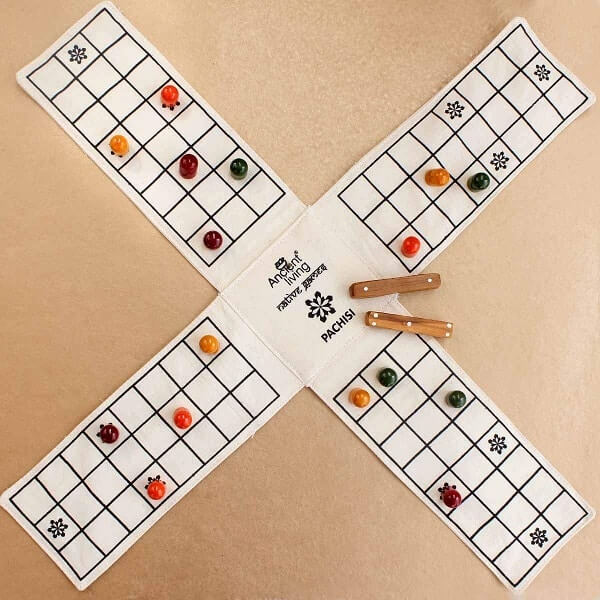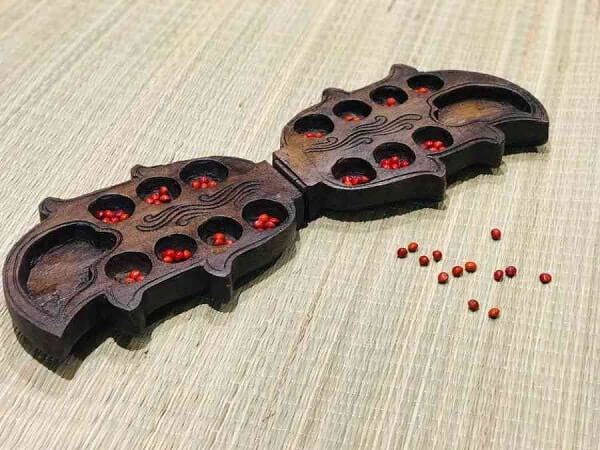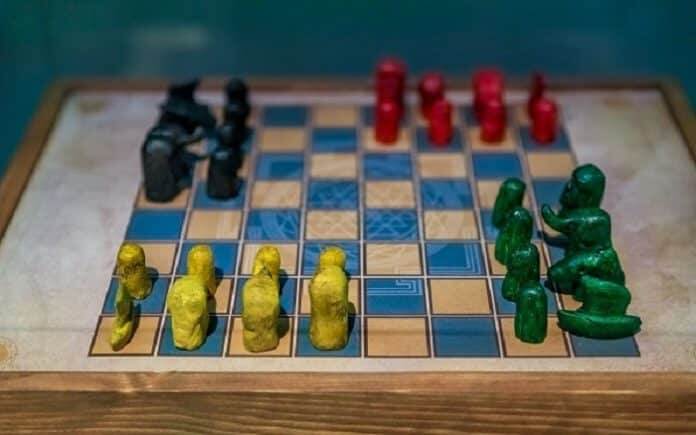When you force your kids to ditch the Playstation/Xbox and play a simple game of Snakes and Ladders or Ludo, are you aware that you are carrying on a 5000-year-old Indian legacy?
In these times of video games and gadgets, the very creative and wise ancient Indian games are slowly being forgotten. Several familiar names like Chess, Snakes & Ladders, Cards, Ludo, Polo, Judo & Karate, Hopscotch and Carrom owe their genesis to India.
Be it Lord Shiva and his consort Parvati playing Pachisi, the Pandavas losing Draupadi over a game of dice, or the Mughals enjoying an afternoon of chess – board games have always played an important role in the history and mythology of India.
Before some of these vanish into the sands of time, let’s strive to revive them, in their authentic Indian form, and what better time than now, amidst COVID lockdown?
Chess (Chaturanga)
Finding a mention in the famous epic Mahabharata, Chaturanga is the origin of the modern game of chess.
Chess in its original Indian form was called Ashtapada – Sanskrit for spider (‘eight-legged’). It was played with dice on an 8×8 checkered board sans white or black colours. Other Indian boards included the 10×10 Dasapada and the 9×9 Saturankam.
Later, this game evolved into what is known as Chaturanga, meaning ‘quadripartite’ (divided into four parts). The two-handed chaturanga was the earliest known form of chess, divided into 4 branches like the army. Like ancient Indian armies, the pieces were called elephants, chariots, horses, and foot soldiers, and played to devise war strategies. The game was played on a cloth surface by 2, 3, or 4 players. Unlike modern chess, Chaturanga combined the strategy of chess with the randomness of a dice roll. It was a battle simulation game that rendered the Indian military strategy of the time.
The account of Persians being introduced to this game is an interesting one. Persian poet Firdousi writes in his historical poem, the Shahnama, about ambassadors from Hind who approached King Chosroes I Anushirwan with a chess board asked him to solve the secrets of the game or pay tribute. The king asked for seven days of grace, during which time wise men vainly tried to discover the secret. Finally, the king’s minister took the pieces home and unravelled the secret in a day and a night.
They named it Shatranj: the term ‘checkmate’ comes from the Persian ‘shah-mat’ meaning ‘the king is dead.’
Cards (Krida Patram)
Abul Fazal, Emperor Akbar’s courtier, wrote in his book Ain-e-Akbari, which is a mirror of the life of that time, about a game played with cards.
Ancient Indian playing cards were called Krida Patram. They were made of cloth pieces and showcased ancient themes from the Ramayana and Mahabharata.
The largest number of such cards are to be found in Orrisa. Fabric painters from Orissa have represented various illustrations like the Navagunjara, a mythical bird-human-animal, the form assumed by Sri Krishna to test Arjuna’s fidelity. Illustrations from the Dashavatara of Vishnu are also portrayed.
The cards were made of cloth, and to obtain the required thickness a number of sheets of pieces of cloth were glued together. The outlines of the rim were painted in black and then the figures were filled in with colour.
In medieval India, they were called Ganifa/ganjifa cards and were played in the royal courts of Rajputana, Kashmir (then Kashyapa Meru), Odisha (then Utkal), the Deccan area as well as Nepal. Nobility and royalty had their cards made from ivory, tortoiseshell, mother of pearl, inlaid, or enamelled with precious metals.
The pack usually consisted of 4 sets of 12 cards each. One set had as its highest rating card the Ashvapati – lord of the horses. The second highest was Senapati (general) followed by ten other cards. Another set of cards had Gajapati (lord of elephants), Senapati and ten others. Another pack had Narpati (king with power over infantry) and other cards like Dhanpati, the lord of treasures; Dalpati the lord of the squadron; Navapati, the lord of the navy; Surapati, the lord of divinities; Asrapati, lord of genii; Vanapati, the king of the forest, and Ahipati, lord of snakes, etc.
The Mughal Ganjifa sets had representations of diverse trades like Nakkash painter, Mujallid bookbinder, Rangrez, dyer, etc., In addition, there were also the Padishah-i-Qimash, king of the manufacturers and Padishah-izar-i-Safid, king of silver, etc.
Later, cards came to be played by all levels of society. Different shapes of cards were in play, most common being circular ones. The art of handmade, hand-painted cards survived for hundreds of years before it was taken over by printed paper cards by the Europeans in the 17-18th centuries.

Ludo (Pachisi)
Before Ludo went online, it used to be a board game. And before it was called Ludo, it was a 4th-century Indian game called Chaupar/Chausar. Made out of cloth or jute, the game finds its mention in the Mahabharat.
The infamous bet in Mahabharat that was played between cousins Pandavas and Kauravas, was a game of Chaturanga, albeit with dices. This epic was dated around 800 to 1000 BC.
Historians point out that there is a depiction of this game in the caves of Ajanta Ellora in Maharashtra, showing that the game was quite popular in the Medieval era. It was also enjoyed by Mughal emperors like Akbar. The British later modified the game to use a cubic dice with a dice cup and patented it as ‘Ludo’ in 1896 in England.
Chausar or Pachisi involves two to four players who use cowry shells and wooden pawns to strategise and plan their manoeuvres and win the game.
Each player’s objective is to move all four of their pieces completely around the board, counter-clockwise, before their opponents do. The pieces start and finish on the Charkoni.
Snakes & Ladders (Moksha Patam)
The childhood favourite Snakes and Ladders, has its origin in India and was called Gyan Chaupar, Mokshapat, Moksha Patamu, or Parama Padam. It was used to teach Hindu values to children.
The game was created by the 13th-century poet saint Gyandev. The ladders in the game represented virtues and the snakes indicated vices. The game was played with cowrie shells and dices. The illustrated squares had a God or one of the heavens (kailasa, vaikuntha, brahmaloka) depicted on the top of a ladder and the bottom described a good quality. Conversely, each snake’s head was a negative quality or an asura (demon). As the game progressed, the various karma and samskara, good deeds and bad took you up and down the board. Interspersed were plants, people, and animals.
The ethics of this concept was a life lesson itself. The good deeds/traits acted like ladders to achieve heaven, whereas the metaphorical evil snake of sins and vices pushed you back into a cycle of re-births.
The British took the game to England in 1892 and named it Snakes and Ladders, and changed it reflect Victorian values.

Pallanguli (Pallankuzhi)
Have you ever played Brainvita? It holds a vague similarity to an ancient game from South India. Variations of the game are called Kuzhipara in Malayalam, Ali Guli Mane in Kannada and Vamana Guntalu in Telugu.
Pallankuli developed skill and quick thinking. Two players competed on a board with 14 cups set out with six seeds in each cup. The players distributed these seeds into the other cups until there were no seeds left. The person who reached two consecutive cups without seeds had to bow out of the game. The player with the maximum number of seeds in the end became being the winner.
It was very popular among women and required good memory and alertness, as they had to count and remember the number of seeds accumulated by the opponent.
READ MORE: How native Indian games help kids with special needs




